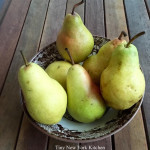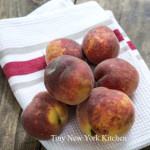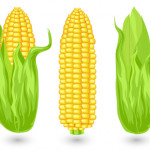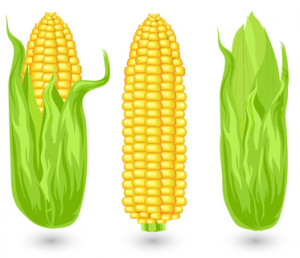Happy Independence Day!
Pears
Season: June to October, but can be cold-stored until spring.
Pears are one of the few fruits that should be picked when under ripe. Buy hard pears a few days before you need them, and let them ripen at room temperature until they have a slight yield when given a gentle squeeze.
To core a pear, cut the pear in half lengthwise, and then scoop out the hard portions with a melon baller. Pear flesh (like apple) oxidizes when exposed to air, so rub the cut areas with lemon juice or white wine to keep them from turning brown.
“Work With What You Got!”
© Victoria Hart Glavin Tiny New York Kitchen © 2016 All Rights Reserved
Because peaches can grow in most of the United States, as long as they’re in season (May through early October) chances are you’ll be able to find organic peaches near you. Look for peaches with flesh that yields slightly to subtle pressure without bruising. Another good indicator of ripeness is the fruit’s background color, behind the red highlights. For yellow peaches (the more tart variety), the background should be a deep gold; for milder white peaches, give them a sniff – they should have a rich, sweet fragrance.
“Work With What You Got!
© Victoria Hart Glavin Tiny New York Kitchen © 2016 All Rights Reserved
Fresh sweet corn is one of life’s pleasures indeed. While corn is available all year-round here in America its true peak season is July through September. This is when corn is at its best.
Buying Tips: Buy ears that are firm and well-shaped under fresh-looking husks with shiny, moist milk. Unshucked corn stays fresh longer. Pick ears that look plump, with kernels running to the tops of the ears. Tiny kernels indicate immaturity, but very large deep yellow kernels can be chewy. The fresher the corn, the sweeter the kernels. With age, the sugar in corn converts to starch. Frozen and canned corn kernels are good substitutes for fresh. Canned baby corn is used in Asian stir-fries. One medium ear of corn yields about 1/2 cup of corn kernels.
Storing: Cook and eat corn as soon as possible after picking. If you must, refrigerate in the crisper drawer up to one or two days.
Preparing: Shuck the corn and remove the silk just before cooking. An exception is corn grilled with the husks intact. To remove the kernels, trim the tips so you can stand the ear on end, then slice down to cut off the kernels, cutting close to the cob.
Cooking: Corn is one of the most versatile vegetables. Sauté the kernels alone or with other vegetables; stir into puddings, fritters, or other batters; or roast, microwave, or boil on the cob. To boil, in a large saucepot, heat 3 inches of water to boiling over a high heat; add the shucked corn and heat to boiling. Do not add salt as it toughens the corn. Reduce the heat to low. Cover and simmer for 5 minutes. Drain.











